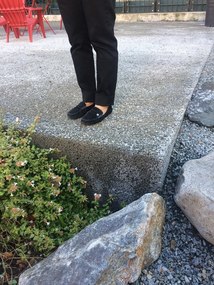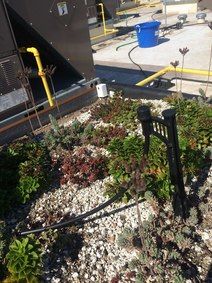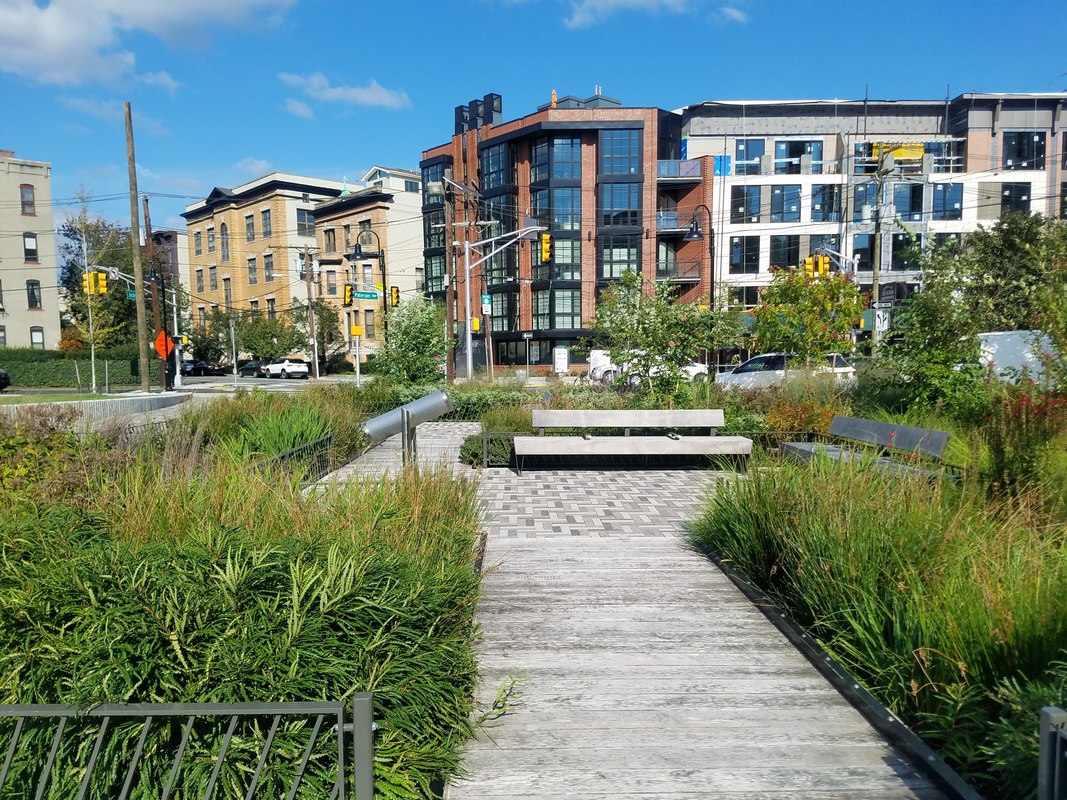| On our tour, we first stopped at City Hall where we met the Chief Resiliency Officer and Chief Sustainability Officer. We learned that Hoboken is in the middle of an ambitious green infrastructure plan. With dozens of parks, right-of-way swales, and stormwater detention basins already constructed, Hoboken is seeking every opportunity to turn hard surfaces into stormwater features. With a population of 50,000 and only about a square mile of land, the city sits very low on the Hudson River, with much of the city only a few feet above sea level. Acknowledging sea level rise, increasing rainfall intensity, and coastal vulnerability to future storms like Hurricane Sandy, Hoboken planners are designing all of their green infrastructure with the foresight for larger, more frequent storms with a higher sea level to protect the city in the future. City Hall is showcasing green infrastructure BMPs (Best Management Practices) through permeable pavement, rainwater harvesting cisterns, rain gardens and a green roof model. We also visited Stevens Institute where we learned about some of the geotechnical constraints to building green infrastructure in Hoboken, such as high water table and clay soils. Stevens professors and students are studying non-infiltrating systems, like concrete-lined planters and green roof systems to maximize stormwater detention in a limited space. Students from Stevens competed in EPA’s Campus RainWorks Challenge in 2015 and won second place for their Master Plan for the campus. One of their proposed green infrastructure techniques was a rain garden that is currently being built out. |
|
On October 3rd, NYC Soil & Water Conservation District took green infrastructure practitioners, city agency representatives, and advocates on a green infrastructure tour in Hoboken NJ. This year’s tour included a bike option, and we had over a dozen participants join the tour using Hoboken’s bike share program, Hudson Bike Share. One of the most exciting stops on our tour was the Southwest Resiliency Park, which is the first of three stormwater parks that are being built to meet the neighborhood’s needs while taking on stormwater from the surrounding area. The design for the park was developed through several community engagement meetings, where city planners asked neighborhood residents what they wanted to see happen on this former parking lot. The park now features a dog park, multi-purpose lawn, and passive recreational space. In addition to rain gardens and bioswales that collect water from the surrounding streets and trees planted in cellular modules to maximize stormwater capture capacity, beneath the park are three stormwater basins that can hold up to 71,000 gallons of water. Next the city is developing the Northwest Resiliency Park on a former brownfield site, and a private developer is building a resiliency park as part of a residential development.
1 Comment
6/5/2022 03:42:17 am
Green infrastructure approaches discussed in the schedule comprise of passable pavements, rain gardens, storm water penetrable planters, etc. The plan recognizes the most economic storm water management of the perfect practices that can be executed within various districts of the city, and adds on an evaluation of how execution will lessen the city's risks to more repeated flood events with a particular emphasize on enhancing the purpose of transit setup and other important assets. In addition to, the Strategic Plan states that presentation-based zoning and more than payments to a Storm water Trust Fund as directing means of bearing revenue and digging private sector action. The City of Hoboken is located over the Hoboken River facing New York City.
Reply
Leave a Reply. |
District Staff
We are the people who run the programs. Archives
August 2023
Categories |



 RSS Feed
RSS Feed